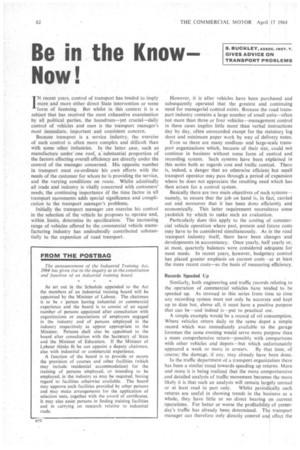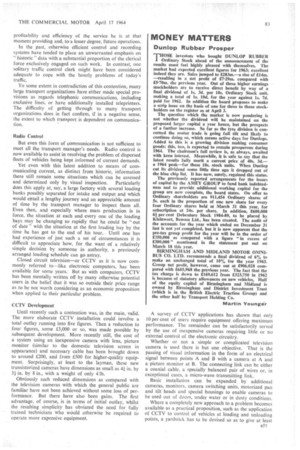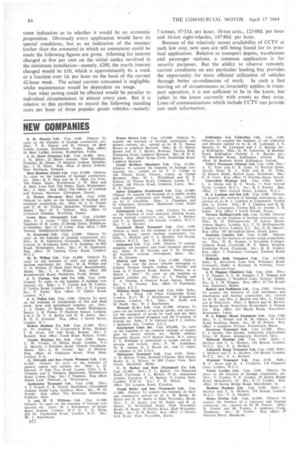Be in the Know Now!
Page 84

Page 85

Page 86

If you've noticed an error in this article please click here to report it so we can fix it.
S. BUCKLEY, ASSOC. INST. T. GIVES ADVICE ON TRANSPORT PROBLEMS IN recent years, control of transport has tended to imply more and more either direct State intervention or some form of licensing. But whilst in this context it is a subject that has received the most exhaustive examination by all political parties, the humdrum—yet crucial—daily control of vehicles and men is the transport manager's most immediate, important and consistent concern.
Because transport is a service industry, the exercise of such control is often more complex and difficult than with some other industries. In the latter case, such as manufacture underone roof, a-substantial proportion of the factors effecting overall efficiency are directly under the control of the manager concerned. His opposite number in transport must co-ordinate his own efforts with the needs of the customer for whom he is providing the service, and the varying conditions on route. Whilst admittedly all trade and industry is vitally concerned with customers' needs, the continuing importance M the time factor in all transport movements adds special significance and complication to the transport manager's problems.
Initially the transport manager can exercise his control in the selection of the vehicle he proposes to operate and, within limits, determine its specification: The increasing range of vehicles offered by the commercial vehicle manufacturing industry has undoubtedly contributed substantially to the expansion of road transport. However, it is after vehicles have been purchased and subsequently operated that the greatest and continuing need for managerial control exists. Because the road transport industry contains a large number of small units—often not more than three or four vehicles—management control in these cases implies little more' than verbal instructions day by day, often unrecorded except for the statutory log sheet and minimum paper work by way of delivery notes.
Even so there are many mediumand large-scale transport organizations which, because of their size, could not continue in business without some form of control and recording system. Such systems have been explained in this series both as regards cost and traffic control. There is, indeed, a danger that an otherwise efficient but small transport operator may pass through a period of expansion where he does not appreciate the resulting need which has then arisen for a control system.
Basically there are two main objectives of such systems— namely, to ensure that the job on hand is, in fact, carried out and moreover that it has been done efficiently and economically. This latter requirement necessitates some yardstick by which to make such an evaluation.
Particularly does this apply to the costing of commercial vehicle operation where past, present and future costs may have to be considered simultaneously. As in the road transport industry itself, there have been changes and developments in accountancy. Once yearly, half yearly or, at most, quarterly balances were considered adequate for most needs. In recent years, however, budgetary control has placed greater emphasis on current costs—or at least the more recent costs—as the basis of measuring efficiency.
Records Speeded Up
Similarly, both engineering and traffic records relating to the operation of commercial vehicles have tended to be speeded up. As stressed in this series from time to time any recording system must not only. be accurate and kept up to date but, above all, it must have a positive purpose that can be—and indeed is—put to practical use.
A simple example would be a record of oil consumption. Where vehicles return daily to the same depot a simple record which was immediately available to the garage foreman the same evening would serve more purpose than a more comprehensive return—possibly with comparisons with other vehicles and depots—but which unfortunately
appeared a week or more in arrears. By that time, of course; the damage, if any, may already have been done.
In the traffic department of a transport organization there has been a similar trend towards speeding up returns. More and more it is being realized that the more comprehensive And detailed analysis of traffic movement becomes the more likely it is that such an analysis will remain largely unread
or at least read in part only. Whilst periodically such returns are useful in showing trends in the business as a whole, they have little or no direct bearing on current operations. For better or worse the profitability of yesterday's traffic has already been determined. The transport manager can therefore only directly control and affect the
profitability and efficiency of the service he is at that moment providing and, to a lesser degree, future operations.
• In the past, otherwise efficient control and recording systems have tended to place an unwarranted emphasis on "historic " data with a substantial proportion of the clerical force exclusively engaged on such work. In contrast, one solitary traffic control clerk might have been considered adequate to cope with the hourly problems of today's traffic.
To some extent in contradiction of this contention, many large transport organizations have either made special provisions as regards telephonic communications, including exclusive lines, or have additionally installed teleprinters. The difficulty of getting through to many transport organizations does in fact confirm, if in a negative sense, the extent to which transport is dependent on communication.
Radio Control But even this form of communication is not sufficient to meet all the transport manager's needs. Radio control is now available to assist in resolving the problem of dispersed fleets of vehicles being kept informed of current demands.
Yet even with this latest addition to means of communicating current, as distinct from historic, information there still remain some situations which can be assessed
and determined only by visual inspection. Particularly does this apply at, say, a large factory with several loading banks possibly separated for intake and output and which would Wail a lengthy journey and an appreciable amount of time by the transport manager to inspect them all. Even then, and especially where mass production is in force, the situation at each and every one of the loading bays may be changing so rapidly that he could be out of date" with the situation at the first loading bay by the time he has got to the end of his tour.Until one has had experience of just such a set of circumstances it is difficult to appreciate how, for the want of a relatively simple decision by someone in authority, a previously arranged loading schedule can go astray.
Closed circuit television—or CCTV as it is now commonly referred to—like electronic computers, has been available for some years. But as with computers, CCTV has been mentally written off by many otherwise potential users in the belief that it was so outside their price range as to be not worth considering as an economic proposition when applied to their particular problem.
CCTV Development Until recently such a contention was, in the main, valid. The more elaborate CCTV installation could involve a total outlay running into five figures. Then a reduction to four figures, some 0,000 or so, was made possible by subsequent development. More recently still, the cost of a system using an inexpensive camera with lens, picture monitor (similar to the domestic television screen in appearance) and necessary cable has been brought down to around £200, and from £500 for higher-quality equipment. Surprisingly, at least to the layman, these new transistorized cameras have dimensions as small as 41 in. by 31in. by 8 in., with a weight of only 4 lb.
Obviously such reduced dimensions as compared with the television cameras with which the general public are familiar have not been achieved without some loss of performance. But there have also been gains. The first advantage, of course, is in terms of initial outlay, whilst the resulting simplicity has obviated the need for fully trained technicians who would otherwise be required to operate more expensive equipment. A survey of CCTV applications has shown that only 10 per cent of users require equipment offering maximum performance. The remainder can be satisfactorily served by the use of inexpensive cameras requiring little or no external control of the electronic circuitry.
Whether or not a simple or complicated television camera is used there is but one objective. That is the passing of visual information in the form of an electrical signal between points A and B with a camera at A and a picture monitor at B. The connecting link can be either a coaxial cable, a specially balanced pair of wires or, in exceptional cases, a micro-wave transmitting link.
Basic installation can be expanded by additional cameras, monitors, camera switching units, motorized pan and tilt heads and special housings to enable cameras to be used out of doors, under water or in dusty conditions.
Where a completely new approach to a problem becomes available as a practical proposition, such as the application of CCTV to control of vehicles at loading and unloading points, a yardstick has to be devised so as to give at least
some indication as to whether it would be an economic proposition. Obviously every application would have its special conditions, but as an indication of the manner (rather than the amounts) in which an assessment could be made the following figures are given. Allowing for interest charged at five per cent on the initial outlay involved in the minimum installation-namely, £200, the yearly interest charged would be £10, which is approximately 4s. a week or a fraction over Id. per hour on the basis of the current 42-hour week. The actual current consumed is negligible, whilst maintenance would be dependent on usage.
Just what saving could be effected would be peculiar to individual circumstances in almost every case. But it is relative to this problem to record the following standing costs per hour of three popular goods vehicles-namely: 7-tonner, 97.35d. per hour; 10-ton artic., 123-00d. per hour and 16-ton eight-wheeler, 147-80d. per hour.
Because of the relatively recent availability of CCTV at such low cost, new uses are still being found for its practical application. Relative to transport depots, warehouses and passenger stations, a common application is for security purposes. But the ability to observe remotely current conditions on any particular loading bay provides the opportunity for more efficient utilization of vehicles through better co-ordination of work. In such a fast moving set of circumstances as invariably applies in trans
port operation, it is not sufficient to be in the know, but•rather in the know currently with events as they arise.
Lines of communications which include CCTV can provide just such information.




































































































































